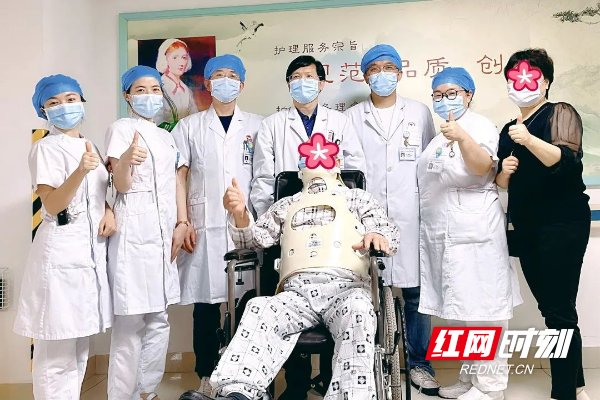
Red Net Moment News May 18 News (correspondent Tan Hao) lives at home Grandpa Wen from Xingsha, Changsha County has suffered from weakness and numbness in both lower limbs and difficulty in walking since the beginning of this year. His life has been seriously affected. After seeing a doctor in many local hospitals, after conservative treatment, the symptoms not only did not relieve, but became more and more serious. For further diagnosis and treatment, he recently came to the Orthopedics and Traumatology Clinic of Changsha Traditional Chinese Medicine Hospital (Changsha Eighth Hospital).
Tan Hao, Deputy Chief Physician of the Second Ward of Orthopedics and Traumatology Department of this department, after inquiring about the medical history and careful physical examination, found that Grandpa Wen had no obvious pressure and percussion pain in the lumbar spine, the straight leg raising test of both lower extremities was negative, and the muscle strength of both lower extremities was negative. Weakened, decreased skin sensation, and walking felt like stepping on cotton, excluding lumbar disc herniation, consider cervical or thoracic vertebrae tumors. Tan Hao explained to the patients and their families the possible causes and treatment methods of the disease, and suggested detailed examination and treatment in hospital.
Completed MRI examination confirmed Tan Hao’s judgment that there was a tumor in the spinal canal in the thoracic 4/5 plane. Due to the high location of the tumor, severe nerve compression, and incomplete paralysis of the lower extremities, coupled with the fact that Grandpa Wen was old and had a variety of medical diseases in the past, the complexity and risk of the operation are self-evident.
In order to ensure the safety of the elderly, before the operation, Tan Yiyun, the director of the department, led the team to discuss repeatedly, fully predict the risks, and take prudent measures. A thorough surgical plan was developed. The operation was held as scheduled. Tan Yiyun and the surgical team successfully performed thoracic 4/5 vertebral subdural tumor resection + thoracic 4/5 vertebral pedicle screw internal fixation and bone graft fusion for Grandpa Wen.
After the operation, the numbness of both lower extremities gradually disappeared, and the muscle strength of both lower extremities gradually recovered. Carry out functional rehabilitation training for both lower extremities and wear braces, the elderly can get out of bed and walk.
Tan Yiyun introduced that intraspinal tumors, also known as spinal cord tumors, refer to tumors that grow in any segment of the spinal cord and tissues close to the spinal cord. The etiology of spinal cord tumors is unknown and may be related to genetics, infection, and environmental physicochemical factors. Spinal cord tumors can cause muscle atrophy, paresthesias, incontinence, and spinal deformities. Spinal cord tumors are mainly treated by surgery, and for those who cannot be operated, drug therapy and radiation therapy can be used. Most benign spinal cord tumors have a good prognosis, while malignant spinal cord tumors have a poor prognosis.
Related Links
I. Typical symptoms of intraspinal tumors
1. Stimulation period
Disease In the early stage, the tumor is small and mainly presents with radicular pain and paresthesia. The common symptom is radicular pain, which extends along the root distribution area, the limbs are linearly distributed, and the trunk is distributed in a band. The painful area is fixed, and some patients may experience night pain or supine pain, which is one of the characteristic manifestations of intraspinal tumors. Radicular pain is the first localization symptom of space-occupying lesions in the spinal canal and outside the spinal cord. Paresthesia is mainly manifested as numbness in one part of the body, ant line feeling and so on.
2. Partial compression of the spinal cord
The tumor enlarges and directly compresses the spinal cord, causing symptoms of compression of the spinal cord tracts. The function of the ascending and descending spinal cord tracts is damaged, causing the limbs below the tumor level of motor and sensory impairments. Patients may experience limb inflexibility, urinary and defecation dysfunction, etc.
3. Complete spinal cord compression stage
Due to the continued growth of the tumor, the compression and aggravation eventually resulted in transverse spinal cord damage. The motor, sensory, and sphincter function of the limbs below the tumor level are completely lost and irreversible. Mainly manifested as unsteady walking, limp, clumsiness, urinary retention, difficulty in defecation, urinary incontinence and so on.
II. Guidelines for seeking medical treatment
When pain, sensory disturbance, movement disturbance, and functional impairment appear, you should seek medical attention in time, and conduct physical examination, tumor markers, cerebrospinal fluid examination, and imaging examination to confirm the diagnosis . Note and epidural abscess, disc herniation, cervical spondylosis, spinal tuberculosis phase identification.
III. Treatment
Surgical treatment is the main method for the treatment of benign spinal cord tumors. For patients with inoperable, tumor recurrence, and malignant metastases, drug therapy and radiation therapy can be performed. The surgical method needs to be comprehensively negotiated in combination with the location, location and size of the tumor, as well as the patient’s age, symptoms, general condition, and the wishes of the patient’s family.